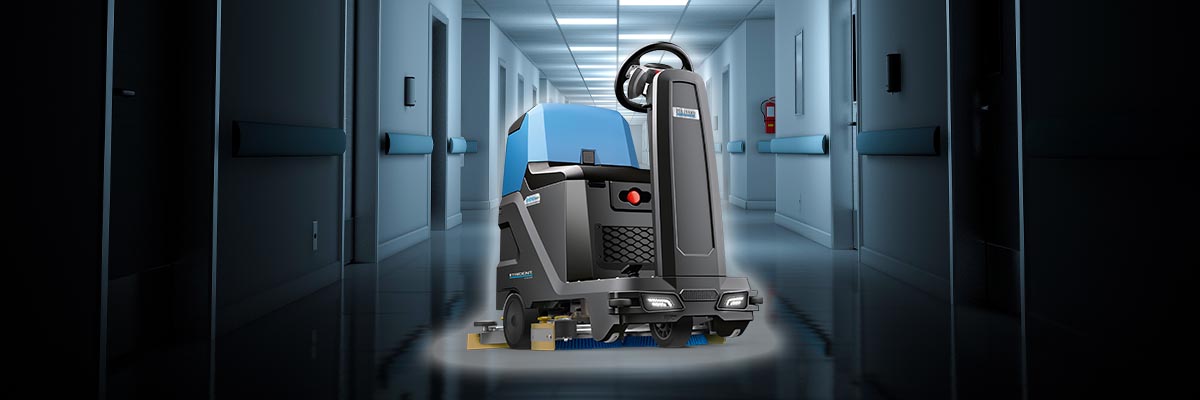Say Goodbye to Stinky Scrubbers: How to Eliminate Odors from Your Floor Scrubber
Maintaining a clean and odor-free recovery tank in your floor scrubber or carpet extractor is crucial for optimal performance and a pleasant user experience. If neglected, foul odors can render the equipment inoperable. The best solution for recovery tank odor is to prevent it in the first place. In this article, we'll talk about why these odors occur, how to fix them, and how to prevent them in the future.

What causes an automatic scrubber to smell bad?
A smelly automatic scrubber can result from several issues related to maintenance and cleaning habits. One primary cause is the failure to drain the recovery tank fully. Neglecting to empty the recovery tank after use allows a sludge-like mix of dirt, water, and soil to accumulate, potentially harboring bacteria and foul smells. If this mixture is allowed to dry, it can be challenging to remove and cause persistent odors even after subsequent cleanings.
How to deodorize a floor scrubber or carpet extractor
- Get proper PPE: Before you start, ensure you have all the PPE required for the products you will use. For the products we recommend in this article, wear rubber or other impervious gloves and splash goggles.
- Drain the recovery tank: Turn off the equipment and drain the recovery tank completely.
- Rinse the tank with clean water: Flush the recovery tank to remove any loose dirt or sludge. If the tank allows, wipe out the interior of the tank with a rag or scrub brush. Continue to rinse the tank until all the residue is gone. If the tank has a debris filter, clean that as well.
- Deodorize the tank: Fill the tank with a cleaning solution that contains hydrogen peroxide. We recommend using either Suprox Multipurpose or Suprox Heavy Duty for this purpose. The Arsenal One Dilution Control System will dilute Suprox Multipurpose at 3 ounces per gallon and Suprox Heavy Duty at 5 ounces per gallon.
- Wait for the Suprox to work: Allow at least 15 minutes for the Suprox to work.
- Drain and rinse the recovery tank: Drain the recovery tank and thoroughly rinse it with clean water to remove any residual cleaning solution.
- Allow the recovery tank to air dry: After rinsing, leave the tank open to air dry completely, preventing any residual moisture from harboring bacteria or mold.
- Look for other sources of odor: Although less common, frequently wet components of an automatic scrubber or carpet extractor can also develop odors. Squeegee assemblies or brushes, for example, can also be sources of odor if they're allowed to stay wet for extended periods. Clean the offending components with diluted Suprox Multipurpose or Heavy Duty. Rinse the components thoroughly after cleaning and allow them to air dry.

Preventing odors in the future
Maintaining odor-free automatic scrubbers and carpet extractors requires a proactive approach to cleaning and maintenance. It is essential to include after-use cleaning in your work instructions to ensure that each machine is properly cared for at the end of every use. This involves draining the recovery tank completely to remove any residual water, dirt, and cleaning solution. Following this, rinsing the tank with clean water and wiping down the interior with a rag or scrub brush will help eliminate any remaining sludge or debris. These simple steps prevent the buildup of bacteria and mold, which are primary causes of unpleasant odors.
Finally, make sure that every component that gets wet is allowed to air dry. This includes the recovery tank, brushes, and squeegees. Dry surfaces prevent the spread of bacteria and mold that can cause odors.
Get Expert Advice about Equipment Maintenance and Odor Control
Hillyard has a network of knowledgeable representatives across the United States who are ready to assist you in developing comprehensive equipment maintenance programs tailored to your needs. Our experts can help you identify and implement best practices to keep your floor scrubbers and carpet extractors operating efficiently and odor-free. Whether you need guidance on routine maintenance tasks or solutions for persistent odor problems, our team is here to provide personalized support and expertise. To get started, simply fill out the form at the bottom of this webpage, and one of our representatives will contact you.
Frequently Asked Questions
Why does my floor scrubber stink?
A smelly automatic scrubber, such as a floor scrubber or carpet extractor, often results from improper maintenance. Failing to fully drain and rinse the solution and recovery tanks allows leftover chemicals and sludge to accumulate and emit unpleasant odors. Thoroughly draining and rinsing the tanks after each use is crucial to prevent bad smells and ensure the equipment remains functional and fresh.
How often should I clean my floor scrubber to prevent odors?
Maintaining your floor scrubber is vital to prevent bad smells and ensure efficient operation. Clean it after every session by draining and rinsing the solution and recovery tanks, and allowing them to air dry to prevent moisture buildup. Regularly check for and remove debris, and wipe all surfaces to keep odors at bay and extend the machine's life.